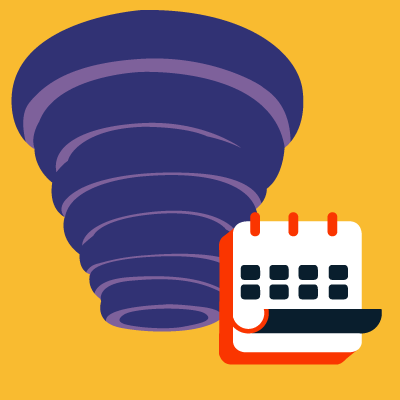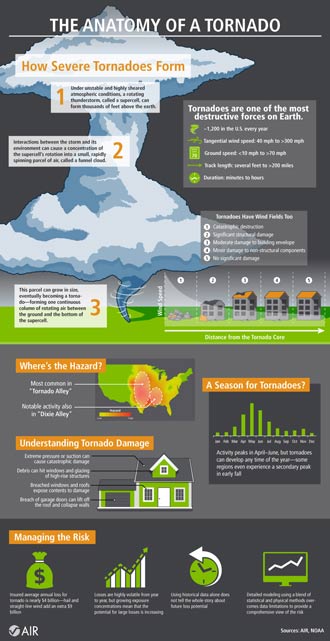
Tornadoes are rapidly rotating columns of air, connected to the base of the thunderstorm and in contact with the ground. Due to its geography, the United States has the most tornado development of any country, with approximately 1,200 tornadoes occurring each year. These storms are some of the most destructive forces in nature, causing an average of 70 deaths and 1,500 injuries annually. Although they can occur at any time of the year, tornadoes are most common between April and June.
Super Outbreak
Forty-five years ago, the United States’ worst tornado outbreak of the 20th century occurred when at least 148 tornadoes struck over the course of 18 hours during April 3 and 4, 1974. More than half of the tornadoes were classified as significant/strong at F2 strength or higher, and there were a remarkable 23 F4s and 7 F5s. (See the section “Intensity Scale” below to learn about the F- and EF-scales.) The tornadoes impacted Illinois, Indiana, Michigan, Ohio, Kentucky, Tennessee, Alabama, Mississippi, Georgia, North Carolina, Virginia, West Virginia, and New York.
The “Super Outbreak” began in Morris, Illinois, at around 1:00 p.m. on April 3. As the storm system moved east where daytime heating made the air more unstable, the tornadoes grew more intense. The outbreak finally ended in Caldwell County, North Carolina, at about 7:00 a.m. on April 4. Damage occurred across 900 square miles and 319 people were killed.
One of the most deadly and damaging tornadoes struck Xenia, Ohio, and killed 32 people and destroyed a significant portion of the town. Apartment buildings, homes, businesses, churches, and schools—including Xenia High School—were destroyed. Another tornado produced F5 damage when it struck Brandenburg, Kentucky. This tornado either leveled or swept away numerous homes, causing 18 fatalities, and mangled cars were thrown hundreds of miles and found wrapped around trees.

Tornado Genesis
The development of a tornado under a supercell is referred to as tornado genesis and is an active area of academic research. It is generally accepted that tornado genesis occurs when rotational momentum from the parent supercell becomes stretched and concentrated. Just as an ice skater increases their rotation through the contraction of their arms, a tornado gains rotational momentum as the updraft and downdraft of the storm stretch and contract the rotating air parcel into a thin column. The strong upward motions within the tornado typically result in the formation of a dark condensation funnel, attached to the cloud base. As the funnel cloud makes contact with the ground, debris and dust are often lifted into the air around the tornado, forming a debris cloud. Often this debris cloud is visible on radar in the form of a “radar debris ball.”
Most tornadoes rotate cyclonically (counter-clockwise in the Northern Hemisphere), with forward wind speeds ranging from stationary to about 70 mph. Tornadoes generally have rotational wind speeds ranging from 40 to 110 mph, although they can reach 300 mph. Weaker tornadoes generally last about 10 minutes and travel only short distances, while stronger tornadoes can last for several hours and can travel hundreds of miles.
Tornadoes tend to vary in intensity regardless of shape, size, and location, although stronger tornadoes tend to be larger than weak ones. Longer-track tornadoes also tend to be stronger than those that have a short track, however these correlations are quite weak given the considerable complexity of severe weather systems.
Intensity Scale
It is difficult to directly measure tornado wind speeds by conventional methods, as the storms are usually small, brief, and occur out of range of weather stations or anemometers. Also, instruments in a tornado’s path are often destroyed by the wind intensity. The Fujita scale, or F-scale, was developed in 1971 as an indirect method for classifying tornado intensity based upon observed damage. In 2007, this scale was updated to the Enhanced Fujita scale, or EF-scale, by a panel of meteorologists and engineers who believed the original F-scale overestimated winds for tornadoes F3 and higher.
The EF-scale is a set of wind-speed estimates, in terms of three-second gusts, based on the observed degree of damage to 28 types of structures called damage indicators. These damage indicators consist of 23 types of buildings—including schools, homes, barns, apartments, retail buildings, and warehouses—and five additional objects, including trees, towers, and poles. The degrees of damage range from the threshold of visible damage to destruction.
EF-0 or EF-1 tornadoes inflict light damage to roofs, gutters, and siding and can break tree branches. At the other end of the Enhanced Fujita Scale, EF-5 tornadoes can inflict damage such as lifting strong frame houses off foundations and causing automobiles to become airborne. In addition, steel reinforced concrete structures can be badly damaged and high-rise buildings may have significant structural deformation. Fortunately, in the United States, approximately 80% of reported tornadoes are EF-0 or EF-1.
“Why Can't Scientists Forecast Tornadoes?” Read Eric Robinson’s blog to find out.



